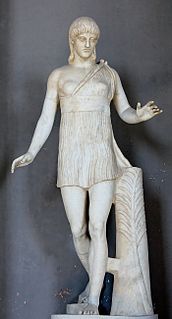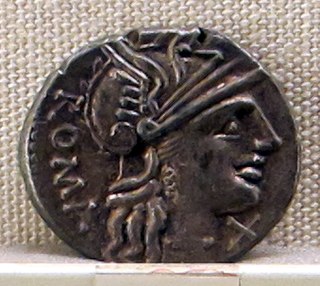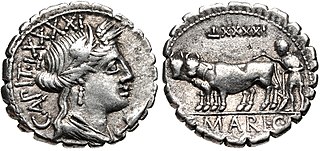Related Research Articles
Gnaeus Domitius Afer was a Roman orator and advocate, born at Nemausus (Nîmes) in Gallia Narbonensis. He flourished in the reigns of Tiberius, Caligula, Claudius and Nero. He was suffect consul in the nundinium of September to December 39 as the colleague of Aulus Didius Gallus.
Julius Africanus was a celebrated orator in the reign of Nero, and seems to have been the son of the Julius Africanus, of the Gallic state of the Santoni, who was condemned by Tiberius in 32 AD. Quintilian, who had heard Julius Africanus, spoke of him and Domitius Afer as the best orators of their time. The eloquence of Africanus was chiefly characterized by vehemence and energy. Pliny the Younger mentions a grandson of this Julius Africanus, who was also an advocate and was opposed to him upon one occasion.

Pasiteles was a Neo-Attic school sculptor from Ancient Rome at the time of Julius Caesar. Pasiteles is said by Pliny to have been a native of Magna Graecia, and to have been granted Roman citizenship. He worked during a period where there was a demand for copies of, or variations on, noted works of Greek sculpture; the demand was met by the workshops of Pasiteles and his pupils Stephanus and Menelaus and others, several of whose statues are extant. According to Pliny, Pasiteles made an ivory statue of Jupiter for the temple of Metellus and made statues for the temple of Juno in the portico of Octavia.
Aegineta was an ancient Greek modeller mentioned by Pliny the Elder. Some scholars supposed that the word Aeginetae in the passage of Pliny denoted merely the country—Aegina—of some artist, whose real name was not given. The consensus of scholarly opinion is now against this hypothesis, however, and it is generally believed that "Aegineta" was the man's given name.
Agamede was a name attributed to two separate women in classical Greek mythology and legendary history.
Minucius Acilianus was born in Brixia, and was the son of Minucius Macrinus, who was enrolled by Vespasian among those of praetorian rank. Like his father, he was also a friend of Pliny the Younger. Acilianus was successively quaestor, tribune, and praetor, and at his death left Pliny part of his property.
Arrianus was a Roman jurisconsult of uncertain date. He probably lived under Trajan, and, according to the conjecture of Grotius, is perhaps the same person as the orator Arrianus, who corresponded with Pliny the Younger. He may also possibly be identical with the Arrianus Severus, praefectus aerarii, whose opinion concerning a constitution Divi Trajani is cited by Aburnus Valens. He wrote a treatise de Interdictis of which the second book is quoted in the Pandects in an extract from Ulpian. In that extract, Proculus, who lived under Tiberius, is mentioned in such a manner, that he might be supposed to have written after Arrianus. There is no direct extract from Arrianus in the Pandects, though he is several times mentioned.

The gens Minucia was an ancient Roman family, which flourished from the earliest days of the Republic until imperial times. The gens was apparently of patrician origin, but was better known by its plebeian branches. The first of the Minucii to hold the consulship was Marcus Minucius Augurinus, elected consul in 497 BC.
Aeschines was an ancient physician who lived in the latter half of the 4th century AD. He was born on the island of Chios, and settled at Athens, where he appears to have practiced with little success, but acquired fame by a cure of Eunapius Sardianus, who on his voyage to Athens had been seized with a fever, which yielded only to treatment of a peculiar nature.
Phradmon was a little-known sculptor from Argos, whom Pliny places as the contemporary of Polykleitos, Myron, Pythagoras, Scopas, and Perelius, at Olympiad 90 in 420 BCE, in giving an anecdotal description of a competition for a Wounded Amazon for the temple of Artemis at Ephesus: in Pliny's anecdote, the fifth place was won by Phradmon, whom Pliny admits was younger than any of the four who were preferred to him. Trusting in Pliny's anecdote, scholars have often hopefully assigned the "Lansdowne" type of Wounded Amazon to Phradmon.
Agesilaus I, son of Doryssus, was the 6th king of the Agiad line at Sparta, excluding Aristodemus. According to Apollodorus of Athens, he reigned forty-four years, and died in 886 BC. Pausanias makes his reign a short one, but contemporary with the legislation of Lycurgus. He was succeeded by his son Archelaus. His grandson was Teleclus.
Marcius Agrippa was originally a slave serving as a beautician. He later became a freedman in some unknown way and then (illegally) started to encroach upon the rank of Equestrian, serving as advocatus fisci during the reign of Septimius Severus. His impersonation of a man of higher rank was discovered shortly afterwards, and the emperor exiled him to an island. He was called back to Rome by the emperor Caracalla, probably given a grant of ingenuitas, and he was elevated to senatorial rank. He was appointed by the emperor Macrinus in 217, first to the government of Pannonia and afterwards to that of Dacia.
Alexis was an ancient Greek sculptor mentioned by Pliny as one of the pupils of Polykleitos. Pausanias mentions an artist of the same name, a native of Sicyon, and father of the sculptor Cantharus. It cannot be satisfactorily settled whether these are the same, or different persons. Pliny's account implies that he had the elder Polykleitos in mind, in which case Alexis could not have flourished later than Olympiad 95 in 400 BC, whereas Eutychides, under whom Cantharus studied, flourished about Olympiad 120 in 300. If the two were identical, as German classicist Friedrich Thiersch thinks, we must suppose either that Pliny made a mistake, and that Alexis studied instead under Polykleitos the Younger, or else that Eutychides, whose date is given by Pliny, was not the artist under whom Cantharus studied.
Alpheus Mytilenaeus was the author of about twelve epigrams in the Greek Anthology, some of which seem to point out the time when he wrote. In the seventh epigram he refers to the state of the Roman Empire, as embracing almost all the known world; in the ninth he speaks of the restored and flourishing city of Troy; and in the tenth he alludes to an epigram by Antipater of Sidon. Antipater lived under Augustus, in the second half of the 1st century BC, and Troy had received great favors from Julius Caesar and Augustus. Therefore, it is not improbable that Alpheus also wrote under Augustus. It is true that in the fourth epigram he addresses a certain Macrinus, but there is no reason to suppose that this was the emperor Macrinus.

The gens Maria was a plebeian family of Rome. Its most celebrated member was Gaius Marius, one of the greatest generals of antiquity, and seven times consul.
The gens Avidia was an ancient Roman family that flourished during the early centuries of the Empire. Several of its members rose to prominence during the late first and second centuries AD.
Calpurnius Flaccus was a rhetorician who lived in the reign of Hadrian, and whose fifty-one declamations frequently accompany those of Quintilian. They were first published by Pierre Pithou in Paris in 1580. Pliny the Younger writes to Flaccus, who, in some editions, is called Calpurnius Flaccus.

The gens Nonia was a plebeian family at ancient Rome. Its members first appear in history toward the end of the Republic. The first of the Nonii to obtain the consulship was Lucius Nonius Asprenas in 36 BC. From then until the end of the fourth century, they regularly held the highest offices of the Roman state.
The gens Minicia was a plebeian family at ancient Rome. Members of this gens are first mentioned in the first century, achieving the consulate under the emperor Claudius. Owing to the similarity of their names, the Minicii are regularly confused with members of the ancient and far more prominent gens Minucia.
Aristagoras was a Greek writer on Egypt who lived somewhere between the 4th and 2nd centuries BCE. The writer Stephanus of Byzantium says that Aristagoras was not much younger than Plato, and from the order in which he is mentioned by Pliny the Elder in the list of authors who wrote upon the pyramids, he would appear to have lived between, or been a contemporary of, Duris of Samos and Artemidorus of Ephesus.
References
- ↑
 Smith, William (1870). "Macrinus". In Smith, William (ed.). Dictionary of Greek and Roman Biography and Mythology . 2. p. 886.
Smith, William (1870). "Macrinus". In Smith, William (ed.). Dictionary of Greek and Roman Biography and Mythology . 2. p. 886. - ↑ Pliny the Younger, Epistulae ii. 7, iii. 4, vii. 6, 10, viii. 17, ix. 4
![]() This article incorporates text from a publication now in the public domain : Smith, William (1870). "Macrinus". In Smith, William (ed.). Dictionary of Greek and Roman Biography and Mythology . 2. p. 886.
This article incorporates text from a publication now in the public domain : Smith, William (1870). "Macrinus". In Smith, William (ed.). Dictionary of Greek and Roman Biography and Mythology . 2. p. 886.